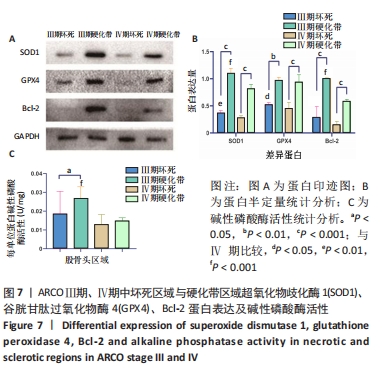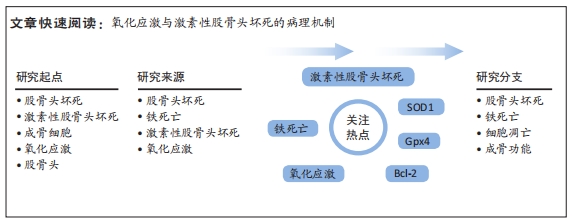2.1 参与者数量分析 该项研究纳入的47 例患者全部进入结果分析。
2.2 激素性股骨头坏死患者的一般资料比较 收集47 例激素性股骨头坏死患者的血清标本,其中Ⅱ期17 例,Ⅲ期17 例,Ⅳ期13 例,各期患者的年龄、性别及侧别之间差异无显著性意义,见表1。
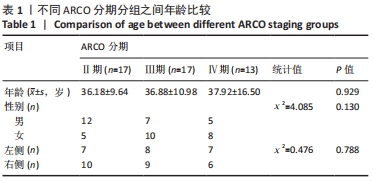
2.3 患者血清中丙二醛、超氧化物歧化酶1的水平 见图1。组间比较不同ARCO分期的激素性股骨头坏死患者血清,Ⅲ期的脂质氧化产物丙二醛及超氧化物歧化酶1水平显著高于Ⅱ期、Ⅳ期。
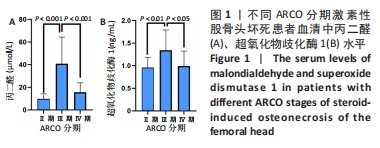
2.4 氧化应激调控铁死亡促进成骨细胞凋亡对激素性股骨头坏死疾病进展的影响
2.4.1 坏死区域与正常区域中蛋白差异 见图2。ARCO Ⅲ期坏死区域vs. ARCO Ⅲ期正常区域,总共1 399 个差异蛋白,其中上调蛋白319 个,下调蛋白1 080 个,见图2A;ARCO Ⅳ期坏死区域vs. ARCO Ⅳ期正常区域,总共1 122 个差异蛋白,其中上调蛋白301 个,下调蛋白821 个,见图2H。
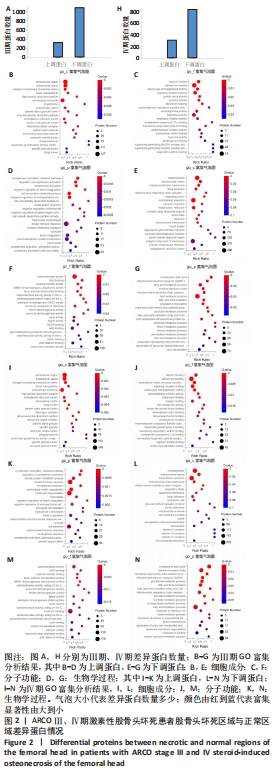
GO富集的结果显示,在细胞成分上,Ⅲ期、Ⅳ期上调蛋白富集最为显著的前3 个均为细胞外区域(extracellular region)、细胞外空间(extracellular space)、含胶原蛋白的细胞外基质(collagen-containing extracellular matrix);下调蛋白富集最显著的前3 个是线粒体(mitochondrion)、线粒体基质
(mitochondrial matrix)、线粒体内膜(mitochondrial inner membrane,
Ⅲ期)、细胞外外泌体(extracellular exosome,Ⅳ期)。
从分子功能上看,Ⅲ期、Ⅳ期上调蛋白富集最显著的前3分布在肝素结合(heparin binding)、钙离子结合(calciumion
binding)、丝氨酸内肽酶活性(serine-type endopeptidase activity,Ⅲ期)、细胞外基质构成(extracellular matrix structural constituent,Ⅳ期);下调蛋白分布在氧化还原酶活性(oxidoreductase activity)、NAD结合(NAD binding)、电子转移活性(electron transfer activity)。
从生物学过程看,Ⅲ期、Ⅳ期上调蛋白富集最显著的前3 个为补体激活经典途径(complement activation,classical pathway)、补体活化的调节(regulation of complement activation)、补体激活(complement activation,Ⅲ期)、细胞代谢蛋白的过程(cellular protein metabolic process,Ⅳ期);下调蛋白分布在三羧酸循环(tricarboxylic acid cycle)、线粒体电子传递,NADH至泛醌(mitochondrial electron transport,NADH to ubiquinone,Ⅲ期)、脂肪酸代谢过程(fatty acid metabolic process,Ⅲ期)、电子传递链(electron transport chain,Ⅳ期)、支链氨基酸代谢(branched-chain amino acid catabolic process,Ⅳ期),见图2B-G,I-N。
对ARCO Ⅲ期、Ⅳ期所获得的富集最显著的前3 个的差异蛋白进行交叉汇总,筛选得出超氧化物歧化酶1、GPX4、B细胞淋巴瘤/白血病2基因(B-cell lymphoma-2,Bcl-2)显著性最大,并对其表达量进行检测,结果显示:Ⅲ期坏死区域超氧化物歧化酶1表达量为10.047 15,GPX4表达量为8.242 656,Bcl-2表达量为NA;正常区域超氧化物歧化酶1表达量为11.707 33;GPX4表达量为9.203 088;Bcl-2表达量为6.719 839。
Ⅳ期坏死区域超氧化物歧化酶1表达量为9.767 843;GPX4表达量为7.493 619;Bcl-2表达量为NA;正常区域超氧化物歧化酶1表达量为11.210 84,GPX4表达量为9.051 671,Bcl-2表达量为6.623 077,见图3。
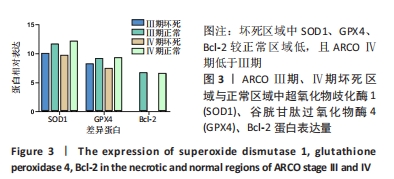
2.4.2 坏死区域与正常区域中的相关蛋白表达及碱性磷酸酶活性 对ARCO Ⅲ期、Ⅳ期坏死区域与正常区域进行Western blot实验,结果显示正常区域中超氧化物歧化酶1、GPX4、Bcl-2蛋白表达量较坏死区域上升;且Ⅲ期患者坏死区域表达量均高于Ⅳ期,见图4A,B。碱性磷酸酶活性结果也显示正常区域高于坏死区域,Ⅲ期患者坏死区域及正常区域表达量均高于Ⅳ期,见图4C。

2.5 氧化应激调控铁死亡促进成骨细胞凋亡对激素性股骨头坏死骨修复的影响
2.5.1 坏死区域与硬化带区域中蛋白差异 见图5。对ARCO Ⅲ期、Ⅳ期坏死区域与硬化带区域的差异蛋白进行筛选,筛选结果为ARCO Ⅲ期坏死区域vs. ARCO Ⅲ期硬化带区域,总共437 个差异蛋白,其中上调蛋白180 个,下调蛋白257 个,见图5A;ARCO Ⅳ期坏死区域vs. ARCO Ⅳ期硬化带区域,总共393 个差异蛋白,其中上调蛋白59 个,下调蛋白334 个,见图5H。
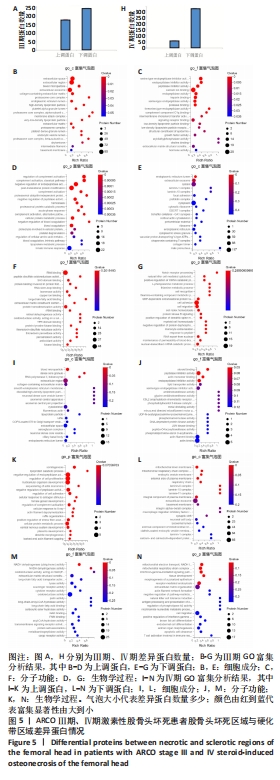
GO富集的结果显示,在细胞成分上,Ⅲ期、Ⅳ期上调蛋白富集最为显著的前3 个为血液颗粒(blood microparticle)、细胞外区域(extracellular region,Ⅲ期)、细胞外空间(extracellular space,Ⅲ期)、致密的核心颗粒(dense core granule,Ⅳ期)、RNA聚合酶全酶(RNA polymerase Ⅱ, holoenzyme,Ⅳ期);Ⅲ期下调蛋白富集最显著的前3 个是细胞外外泌体(extracellular exosome)、内质网腔(endoplasmic reticulum lumen)、胞浆(cytosol);Ⅳ期为线粒体内膜(mitochondrial inner membrane)、线粒体呼吸复合体Ⅰ(mitochondrial respiratory chain complexⅠ)、内吞囊泡膜(endocytic vesicle membrane)。
从分子功能上看,Ⅲ期、Ⅳ期上调蛋白富集最显著的前3分布在肽酶抑制剂活性(peptidase inhibitor activity)、丝氨酸内肽酶活性(serine-type endopeptidase activity,Ⅲ期)、内肽酶抑制剂活性(endopeptidase inhibitor activity,Ⅲ期)、类固醇结合(steroid binding,Ⅳ期)、肌动蛋白单体结合(actin monomer binding,Ⅳ期);Ⅲ期下调蛋白分布在RNA结合(RNA binding)、肽二硫氧化还原酶活性(peptide disulfide oxidoreductase activity)、SH3域绑定(SH3 domain binding);Ⅳ期分布在NADH脱氢酶(泛醌)活性[NADH dehydrogenase (ubiquinone) activity]、NADH脱氢酶活性(NADH dehydrogenase activity)、氧化还原酶活性,作用于NAD(P)H[oxidoreductase activity,acting on NAD(P)H]。
从生物学过程看,Ⅲ期、Ⅳ期上调蛋白富集最显著的前3 个为内肽酶负调节作用(negative regulation of endopeptidase activity)、补体激活经典途径(complement activation,classical pathway,Ⅲ期)、补体活化的调节(regulation of complement activation,Ⅲ期)、丝分裂形成(somitogenesis,Ⅳ期)、脂蛋白分解代谢过程(lipoprotein catabolic process);Ⅲ期下调蛋白分布在Notch受体处理(Notch receptor processing)、自然杀伤细胞介导的细胞毒性(natural killer cell mediated cytotoxicity)、mRNA分解代谢的正向调控(positive regulation of mRNA catabolic process);Ⅳ期分布在线粒体电子传递,NADH至泛醌(mitochondrial electron transport,NADH to ubiquinone)、线粒体呼吸链复合体Ⅰ(mitochondrial respiratory chain complex I assembly)、干扰素-γ介导的信号通路(interferon-gamma-mediated signaling pathway),见图5B-G,I-N。
对ARCO Ⅲ、Ⅳ期获得的富集最显著的前3 个差异蛋白进行交叉汇总,筛选得出超氧化物歧化酶1、GPX4、Bcl-2显著性最大,并检测其表达量,结果显示:Ⅲ期坏死区域超氧化物歧化酶1表达量为10.047 15,GPX4表达量为8.242 656,Bcl-2表达量为NA;硬化带区域超氧化物歧化酶1表达量为12.074 71,GPX4表达量为8.932 875,Bcl-2表达量为6.232 899。Ⅳ期坏死区域超氧化物歧化酶1表达量为9.767 843,GPX4表达量为7.493 619,Bcl-2表达量为NA;硬化带区域超氧化物歧化酶1表达量为11.435 61,GPX4表达量为8.288 634,Bcl-2表达量为6.147 253,见图6。
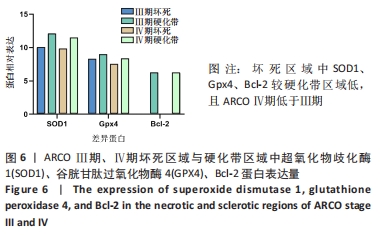
2.5.2 坏死区域与硬化带区域中相关蛋白表达及碱性磷酸酶活性 对ARCO Ⅲ期、Ⅳ期坏死区域与硬化带区域进行Western blot实验,结果显示硬化带区域中超氧化物歧化酶1、GPX4、Bcl-2蛋白表达量较坏死区域上升,且Ⅲ期患者坏死区域硬化带表达量均高于Ⅳ期,见图7A,B。碱性磷酸酶活性结果也显示硬化带区域高于坏死区域,Ⅲ期患者坏死区域及硬化带区域表达量均高于Ⅳ期,见图7C。
